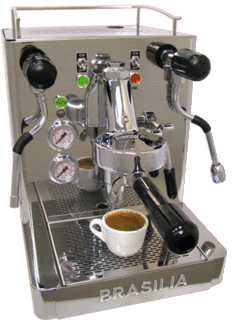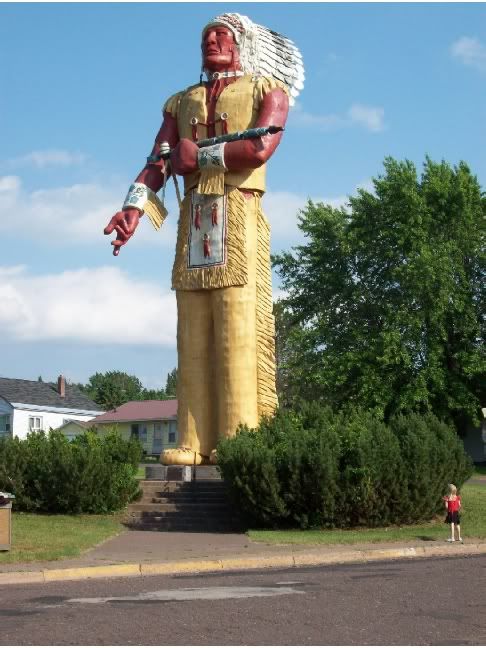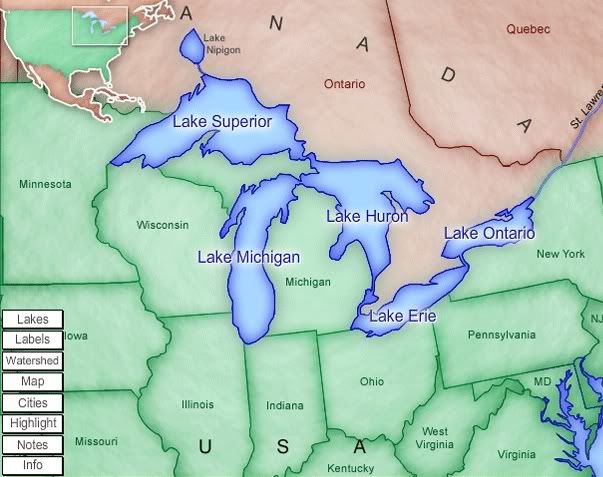 History of the Espresso Machine (aabreecoffee.com)
History of the Espresso Machine (aabreecoffee.com)
Espresso as a beverage and understood term dates back to 1901 when Luigi Bezzera patented the world's first "espresso" machine, a giant steam driven thing with two groupheads called the Tipo Gigante. Luigi's machine had been developed to help reduce the time his employees took for a coffee break. The owner of a manufacturing company, Bezzera needed to increase the production of his employees, so a faster "coffee maker" was the key, he thought. His invention yielded a coffee maker that used a combination of water and steam, forced under high pressure through coffee grounds, to rapidly brew the coffee. It was dubbed the "espresso machine."
However, there was a downside to Luigi's machine. Brewing with a combination of steam and hot water under pressure did produce a cup of coffee faster than other brewers of the time, but the resulting brew was bitter. Desiderio Pavoni, who purchased Bezzera's patent in 1905, was the first person to realize that the bitterness was the result of the steam and the very high temperatures it imposed on the coffee grounds. So, Pavoni began experimenting with various temperatures and pressures, and eventually concluded that brewing at 195 degrees with 8-9 BAR of pressure produced the best results. This is the basis for espresso as we know it today.
The modern day espresso machine dates back to 1947, when Gaggia introduced the Gaggia Crema Caffe machine. This was the first machine capable of consistently introducing pressurized water (8 BAR or higher) into a bed of coffee, and easily and cheaply enough for normal commercial use. Before that, almost every commercial and consumer espresso machine was steam driven and therefore, more akin to the modern day moka brewer.
Here are some other milestones in the history of the espresso machine and the resulting beverage.
Espresso Machine Time Line
1901 - Luigi Bezzera patents his Tipo Gigante, the precursor to what would become espresso machine technology for the next fifty years. Luigi wanted to reduce coffee break times so he made a machine that brewed “coffee” much faster using pressure. Espresso (in a loose translation) means “fast” in Italian.
1905 - Desiderio Pavoni buys Bezzera's patents. La Pavoni was the first manufacturer of espresso machines to be used in coffee bars. Also, Pier Teresio Arduino founds Victoria Arduino, the company that would do more to spread early espresso culture than any other with its advertisements and philosophy behind the drink.
1912 - La Cimbali founded. They are makers of fine high-end home and large capacity espresso machines.
1922 - Universal enters the espresso machine business and soon becomes the leading machine maker with a wide range of products through the 1920s and 1930s and beyond. (They have since disappeared from the market).
1927 - La Marzocco founded. The first espresso machine comes to America as NYC's Regio's Bar installs a La Pavoni two-group machine that is still on display today.
1929 - Rancilio founded by Roberto Rancili.
1932 - La San Marco starts a 10+-year trend towards total Deco design in machines with the introduction of the La San Marco 900. Every company would move to this design style.
1936 - Simonelli founded, who later became makers of medium to heavy-duty espresso machines.
1938 - M. Cremonesi developed a piston pump that forced hot, but not boiling, water through the coffee. The piston pump was quite an improvement as it eliminated the burnt taste of coffee, which occurred in the Pavoni machines.
1946 - Faema founded by Ernesto Valente.
1947 - Gaggia introduces the revolutionary piston lever Crema Caffe machine and modern day espresso in the commercial establishment is born. Many will follow.
1948 - Gaggia introduces the Classica, a 2-group version of the Crema Caffe; La Pavoni, other companies introduce new brewers based loosely on Gaggia's revolutionary system. True espresso, as we know it today, becomes common.
1950 - Elektra experiments with hydraulic pressure machines.
1950 (circa) - Officine Maffioletto makes one of the first machines capable of brewing real pressure espresso, but in the home. It was a piston model with a 1-liter capacity.
1950's - Piston operated machines, both spring action and direct pressure, many direct copies of Gaggia's ground breaking Crema machines, flood the market and make modern day espresso common.
1956 (circa) - Gaggia Gilda machine, not marketed for, but suitable for home use is brought to the market - a dual lever piston single group machine.
1958 - La Marzocco Crema Espress single group lever machine is introduced.
1961 - Faema introduces a very revolutionary machine, the E61 - the first heat exchanger, rotary pump driven espresso machine. Elektra Micro Casa a Leva and La Pavoni Europiccola Lever machine for the home are introduced. Micro Casa had "steam on demand" ability.
1966 - Alfred Peet opens first Peets Coffee in Berkeley, CA later serves as inspiration for the founding of Starbucks by visiting Seattlites.
1971 - Starbucks first opens in Seattle as a roastery.
1974 - La Pavoni Professional Lever machine for the home is introduced. Pavoni introduces "instant steam" and brew machine.
1982 - SCAA founded. Originally called the Specialty Coffee Advisory Board or SCAB; they would soon change their name to something more pleasing to the ear.
1983 - Howard Schultz of Starbucks travels to Italy and becomes immersed in espresso culture.
1985 - Starbucks installs the first espresso machine in their Seattle shop.
1989 - Acorto brings to market the world's first truly complete and marketable commercial super automatic machine, including groundbreaking features such as the self-contained refrigeration system for milk, and different frothing choices on demand.
1990 - Rancilio introduces the Rocky Burr Grinder - a grinder that blurs the line between commercial and home grinding appliances.
1991 (circa) - Saeco brings out the world's first super automatics designed specifically for home and small office use.
1992 - Illy collector cups first introduced, bringing artistry to the cup itself, as well as what's inside the cup.
1994 - Solis brings the SL-90 consumer espresso machine to market, one of the first successful automatic espresso machines for the home.
1997 - Rancilio introduces the Rancilio Silvia, which raises the bar in the home espresso machine market and starts a trend towards better, more professional machines for the consumer. Pasquini markets the Livia 90 (made by Bezzera), one of a new wave of prosumer, heat exchanger-equipped machines for consumers instead of commercial businesses.
1997 - Aabree Coffee Company goes on the web.
Of course, this list is by no means complete. It is presented to give you an idea about several things, including the fact that espresso existed long before the big coffee chains were around. And even though those chains and espresso are somewhat reliant on one another, I'd wager that espresso will far outlast any of the chain coffeehouses you and I know so well. With its unique culture and growing number of devotees who are ultimately dedicated to the betterment of the brew, I'm ready to see what the next hundred years has in store for espresso.
.
Thursday, April 29, 2010
Luigi Bezzera: Milanese Inventor of the Espresso Machine
Tuesday, April 13, 2010
Iron Crown to Ironwood III
 As we have covered before, and it still amazes me, there are so many connections and ironies that tie our Lombardian heritage with the Upper Peninsula of Michigan and northern Wisconsin. The more I look into it, the more I see. I found one old article online, which I have misplaced, about immigrants from Lombardy in Duluth, Minnesota a century ago. Duluth is one of the main ports along the Great Lakes, on the eastern shore of Lake Superior, not far from Ironwood. I will post that article when I find it.
As we have covered before, and it still amazes me, there are so many connections and ironies that tie our Lombardian heritage with the Upper Peninsula of Michigan and northern Wisconsin. The more I look into it, the more I see. I found one old article online, which I have misplaced, about immigrants from Lombardy in Duluth, Minnesota a century ago. Duluth is one of the main ports along the Great Lakes, on the eastern shore of Lake Superior, not far from Ironwood. I will post that article when I find it.
Another piece of information that was brought to my attention from one of our friends, is that certain Lombardians, especially from the Bergamo Alps, were prized as lumberjacks. Probably due to their long rugged Alpine roots. Many did seasonal work in France, for example; or continued their work in the American Northwoods or Canada.
I should point out here that I had made an error in this 'Iron Crown to Ironwood' series. I mistakenly referred to the Upper Peninsula of Michigan as "northern Michigan." The Upper Peninsula, or U.P., is a historically remote region which is totally disattached from the main part of Michigan. I had the region correct, just the name was incorrect. The U.P. was originally given to the state of Michigan long ago as part of a settlement with the state of Ohio. Ohio wanted the Great Lakes port city of Toledo, which was part of Michigan at that time.
Natives of the U.P. are known as "Yoopers." Yoopers have their own regional dialect, which is sometimes referred to as "Finglish," or Engish with imput from the many Finnish and German pioneers of the region. The remoteness of the area had much to do with this as well. There are many light-hearted jokes about Yoopers and the Yooper dialect, in the same way as there are with any regional phenomenon, like "Cajun Country." For example, here is a Yooper "glossary." Another example from YouTube: In Search of the Elusive Yooper. There is even a traveling comedy show called "Da Yoopers."
[Above: From Wikipedia >>> "Ironwood is home of the 'World's Tallest Indian' : a 52 ft (15.8 m) fiberglass statue of tribal leader Hiawatha."]
 Although I don't have the names and information handy, I did want to make mention that there were two Lombardian immigrants who had a large impact on the Ojibway tribe of the region (west Wisconsin and towards Minnesota and Canada). One man was one of the predominant Catholic missionaries and educators; and the other man did much research into the Ojibway language, which was fading away at that time. He wrote a book on the language, which is now in the Library of Congress. I just don't have that information handy right now, but it's particularly interesting in that there really were not many Lombardian immigrants in the history of the United States, yet they had such a big impact. Our ballpark figure is that there may have been somewhere between fifty to one hundred thousand Lombardian immigrants since the 1600s. We have covered the story of Eugenio Beltrami before, whose exploration in the early 1800s was in this general area.
Although I don't have the names and information handy, I did want to make mention that there were two Lombardian immigrants who had a large impact on the Ojibway tribe of the region (west Wisconsin and towards Minnesota and Canada). One man was one of the predominant Catholic missionaries and educators; and the other man did much research into the Ojibway language, which was fading away at that time. He wrote a book on the language, which is now in the Library of Congress. I just don't have that information handy right now, but it's particularly interesting in that there really were not many Lombardian immigrants in the history of the United States, yet they had such a big impact. Our ballpark figure is that there may have been somewhere between fifty to one hundred thousand Lombardian immigrants since the 1600s. We have covered the story of Eugenio Beltrami before, whose exploration in the early 1800s was in this general area.
When looking at the history of the Ironwood area from the 1890s onward, it seems clear that Ironwood was very blue collar and socially conservative. The Knights of Labor had a chapter in Ironwood, which was on the Michigan side of the Montreal River. On the Wisconsin side, there was Hurley. Hurley was the "Deadwood" frontier town of this region. It had an outrageous reputation for vice and violence, especially on Silver Street. All of this was, of course, long ago. However, even today, tiny Hurley is known for it's small strip clubs along Silver Street. A small reminder of the towns' past.
Lastly, I just wanted to mention that today, Hurley is 30.3% "Italian." This is the usual vague demographic or descriptive catch-all term that we have become accustomed to our entire lives. From what I have been able to gather, a high percentage of that must be Lombardian. There were also some immigrants from Southern Italy.
**************************************************
8-3-10 Addition: One good link which is appropriate here is one for local businesses, sites, and organizations in the Ironwood/Hurley area, for anyone interested in visiting.
**************************************************
6-27-11 Addition: Somewhat coincidently, since I have roots in Hurley, I discovered that race car driver Tony Ave is from Hurley. I don't know if he has roots in Lombardy or not however. Last Friday I was at the time trials for the NASCAR sprint cup at the Infineon Raceway in Sonoma, California, and I saw Ave race. He didn't make the time trial, but it reminded me that I had read that he was from Hurley.
.
